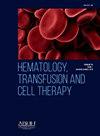18f-fdg和68ga-psma pet / ct在多发性骨髓瘤中基于ct的骨体积定量的比较稳定性
IF 1.6
Q3 HEMATOLOGY
引用次数: 0
摘要
介绍/论证从混合核医学设备获得的计算机断层扫描(CT)图像显示出PET图像分割的巨大潜力。先前对多发性骨髓瘤(MM)患者的研究已经证明了从18F-FDG PET/CT图像的CT数据计算骨体积(BV)的可行性。这种分割技术允许提取整个骨骼的平均标准化摄取值(SUVmean)、骨骼受累百分比(PBI)和骨骼受累强度(IBI)等变量。本研究的目的是确定基于CT霍斯菲尔德单位(HU)的BV量化在不同的放射性示踪剂中是否稳定。目的比较18F-FDG和68Ga-PSMA在MM患者PET/CT扫描中的BV计算。材料和方法本研究包括15例活检证实有症状的MM患者(53%男性,平均年龄66.7±10.7岁),在1至8天的间隔内进行18F-FDG和68Ga-PSMA PET/CT扫描。该研究得到当地伦理委员会(CAAE 91231918.0.0000.5404)的批准。使用PET图像预分割的Beth Israel插件计算BV,应用阈值HU >;One hundred.。使用FIJI将裁剪的PET图像转换为二进制格式,然后应用形态学关闭图像处理工具在二进制轮廓中包括骨髓等区域。对于18F-FDG PET,由于大脑摄取引起的重叠伪影,在预分割期间将颅骨排除在外。描述性统计用于比较每位患者的FDG和PSMA BV计算,并评估相对于FDG衍生BV的个体百分比偏差。采用Spearman等级相关系数(rₛ)评价BV值之间的相关性,显著性水平为p <;0.05.结果18F-FDG PET/CT与68Ga-PSMA PET/CT的BV个体平均百分比偏差为13±3%,范围为7% ~ 20%。在BV值之间观察到很强的正相关(p = 3 × 10⁻¹⁰),并且有很强的Spearman相关系数(rₛ = 0.98)。结论尽管在18F-FDG的BV计算中排除了颅骨,但结果表明,与PSMA PET/CT得出的全骨架BV相比,BV的降低幅度很小。两种放射性示踪剂的BV值之间非常强的相关性表明,分割方法在不同的PET示踪剂之间保持一致。此外,对患者颅骨的比例排除支持了BV量化方法的可靠性。本文章由计算机程序翻译,如有差异,请以英文原文为准。
COMPARATIVE STABILITY OF CT-BASED BONE VOLUME QUANTIFICATION USING 18F-FDG AND 68GA-PSMA PET/CT IN MULTIPLE MYELOMA
Introduction/Justification
Computed Tomography (CT) images obtained from hybrid nuclear medicine equipment have shown great potential for PET image segmentation. Previous studies in patients with Multiple Myeloma (MM) have demonstrated the feasibility of calculating bone volume (BV) from CT data in 18F-FDG PET/CT images. This segmentation technique allows for the extraction of variables such as mean Standardized Uptake Value (SUVmean), Percentage of Bone Involvement (PBI), and Intensity of Bone Involvement (IBI) across the entire skeleton. The aim of this study is to determine whether BV quantification based on CT Hounsfield units (HU) is stable across different radiotracers.
Objectives
To compare BV calculations from PET/CT scans using 18F-FDG and 68Ga-PSMA in patients with MM.
Materials and Methods
This study included 18F-FDG and 68Ga-PSMA PET/CT scans performed within a 1 to 8-day interval in 15 patients (53% male, mean age 66.7 ± 10.7 years) with biopsy- confirmed symptomatic MM. The study was approved by the local Ethics Committee (CAAE 91231918.0.0000.5404). BV was calculated using the Beth Israel plugin for PET image pre-segmentation, applying a threshold of HU > 100. The cropped PET images were converted to binary format using FIJI, followed by the application of a morphological closing image processing tool to include areas such as bone marrow within the binary contour. For 18F-FDG PET, the skull was excluded during pre-segmentation due to overlapping artifacts caused by cerebral uptake. Descriptive statistics were used to compare FDG and PSMA BV calculations for each patient, with individual percentage deviation assessed relative to the FDG-derived BV. The correlation between BV values was evaluated using Spearman's rank correlation coefficient (rₛ), with a significance level of p < 0.05.
Results
The average individual percentage deviation in BV between 18F-FDG PET/CT and 68Ga-PSMA PET/CT was 13 ± 3%, with a range of 7% to 20%. A strong positive correlation was observed between BV values (p = 3 × 10⁻¹⁰), with a very strong Spearman correlation coefficient (rₛ = 0.98).
Conclusion
Despite the exclusion of the skull in BV calculations for 18F-FDG, the results indicate a minimal decrease in BV compared to whole-skeleton BV derived from PSMA PET/CT. The very strong correlation between BV values for the two radiotracers suggests that the segmentation approach remains consistent across different PET tracers. Additionally, the proportional exclusion of the skull across patients supports the reliability of the method for BV quantification.
求助全文
通过发布文献求助,成功后即可免费获取论文全文。
去求助
来源期刊

Hematology, Transfusion and Cell Therapy
Multiple-
CiteScore
2.40
自引率
4.80%
发文量
1419
审稿时长
30 weeks
 求助内容:
求助内容: 应助结果提醒方式:
应助结果提醒方式:


